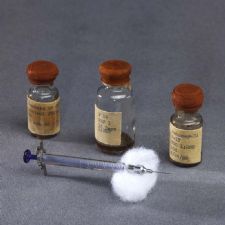On September 6, 2013, Plimoth Plantation (Plymouth, Mass.) will donate a mishoon to the National Museum of the American Indian. Created this past spring by the Wampanoag Indigenous Program (WIP) at Plimoth Plantation, members of the WIP will present the mishoon and accompanying paddles to NMAI in a special gift ceremony at the museum’s Cultural Resources Center in Suitland, Maryland.
“As a museum dedicated to the history and culture of Native American communities, we’re delighted to welcome a creation like this one that represents a living tradition among the Wampanoag,” says Kevin Gover (Pawnee) Director, National Museum of the American Indian.
So what is a mishoon? During the 17th century, the mishoon–a traditional Native American canoe–was the most common boat in North American waters. A typical 17th-century mishoon was created from a giant tree and capable of carrying 40 men. The mishoon being accepted into the NMAI collection isn’t quite that large–it’s 16 feet long and can fit up to 3 people–but it was created in the traditional way.

Photo courtesy Plimoth Plantation.

Photo courtesy Plimoth Plantation.
So how does one create a mishoon? Picking the tree is the first step of course. With the help of Gurney’s Lumber Yard in Freetown, Massachusetts, WIP selected a white pine. The tree was burned down by wrapping clay around the trunk and burning the roots. It was then brought to Plimoth Plantation’s Wampanoag Homesite, where the log was worked with fire. By burning into the widest point of the tree a natural keel is created, where the bottom of the boat is thicker than its sides. Historically, mishoons were burned 24 hours a day, since the longer the fire was maintained the hotter it would get. Typically, it would take about 10-12 days for mishoons to be created in the 17th century. Although this seems like a long time, trees during this period were typically over 150 feet tall and 6 feet wide, capable of creating the mishoons that could carry 40 men.
“It’s an honor that the Smithsonian will accept it, and we enjoy doing new work–it keeps the job challenging,” said Darius Coombs, Associate Director of the Wampanoag Indigenous Program. “It has been a fun and educational experience. The mishoon is an invaluable piece that will add depth to the Smithsonian’s already rich representation of Northeast Native life.”
Smithsonian Affiliations and NMAI will be tweeting live on September 6 as the #mishoon enters the collection. Follow @SIAffiliates, @SmithsonianNMAI, and @Plimoth and check out our Flickr group for photos from the event.

Mishoonash in the Eel River next to Plimoth Plantation’s Wampanoag Homesite. Photo courtesy Smithsonian Affiliations.
Plimoth Plantation has received some amazing press coverage of the donation. Check it out below:
https://www.capecodonline.com/apps/pbcs.dll/article?AID=/20130905/NEWS/309050323
https://www.therepublic.com/view/story/7432b135bbb744ff90f829a97a073bc5/MA–Wampanoag-Canoe-Smithsonian
https://www.enterprisenews.com/news/x1281953326/Plimoth-Plantation-makes-replica-of-Native-American-canoe-for-Smithsonian
https://www.patriotledger.com/topstories/x1281953326/Plimoth-Plantation-makes-replica-of-Native-American-canoe-for-Smithsonian
https://www.wickedlocal.com/plymouth/news/x1843580627/PLIMOTH-PLANTATION-Mishoon-accepted-by-Smithsonian-National-Museum-of-the-American-Indian
https://plymouth.patch.com/groups/around-town/p/smithsonian-accepts-dugout-canoe-from-plimoth-plantation
https://www.pr-inside.com/smithsonian-s-national-museum-of-r3786683.htm
https://www.wbur.org/2013/09/03/wampanoag-canoe-smithsonian
https://www.boston.com/news/local/massachusetts/2013/09/02/wampanoag-canoe-headed-the-smithsonian/kNmhDOOWTQnB2VkOQmMiUO/story.html?rss_id=Top+Stories
https://ww.abc6.com/story/23319713/wampanoag-canoe-headed-to-the-smithsonian
https://bostonherald.com/news_opinion/local_coverage/2013/09/wampanoag_canoe_headed_to_the_smithsonian
https://www.dailyjournal.net/view/story/7432b135bbb744ff90f829a97a073bc5/MA–Wampanoag-Canoe-Smithsonian/#.UiX9idIp8to
https://www.eagletribune.com/boston/x335461568/Wampanoag-canoe-headed-to-Smithsonian
https://www.myfoxboston.com/story/23319713/wampanoag-canoe-headed-to-the-smithsonian
https://www.necn.com/09/02/13/Wampanoag-canoe-headed-to-the-Smithsonia/landing.html?&apID=7432b135bbb744ff90f829a97a073bc5
https://www.newstimes.com/news/article/Wampanoag-canoe-headed-to-the-Smithsonian-4781724.php
https://www.telegram.com/article/20130902/APN/309029676
https://www.news10.com/story/23319713/wampanoag-canoe-headed-to-the-smithsonian
https://www.gadsdentimes.com/article/20130902/APN/1309020791
https://www.cbs3springfield.com/story/23319713/wampanoag-canoe-headed-to-the-smithsonian
https://www.news-journalonline.com/article/20130902/APN/1309020791
https://www.sfgate.com/news/article/Wampanoag-canoe-headed-to-the-Smithsonian-4781724.php
https://www.the-dispatch.com/article/20130902/APN/1309020791
https://www.wtnh.com/news/massachusetts/ap-massachusetts/wampanoag-canoe-headed-to-the-smithsonian_70775095
https://www.seattlepi.com/news/article/Wampanoag-canoe-headed-to-the-Smithsonian-4781724.php
https://www.houmatoday.com/article/20130902/APN/1309020791
https://www.ctpost.com/news/article/Wampanoag-canoe-headed-to-the-Smithsonian-4781724.php
https://www.sportballa.com/2013/09/indigenous-peoples/canoe-headed-wampanoag-smithsonian
https://www.chron.com/news/article/Wampanoag-canoe-headed-to-the-Smithsonian-4781724.php
https://www.dailycomet.com/article/20130902/APN/1309020791
https://www.mysanantonio.com/news/article/Wampanoag-canoe-headed-to-the-Smithsonian-4781724.php
https://www.heraldtribune.com/article/20130902/APN/1309020791
https://www.theledger.com/article/20130902/APN/1309020791
https://www.gainesville.com/article/20130902/APN/1309020791
https://ewallstreeter.com/wampanoag-canoe-headed-to-the-smithsonian-37
https://www.roonte.com/www/wampanoag-canoe-headed-to-the-smithsonian
https://boston.cityandpress.com/node/6741978
https://news.silobreaker.com/wampanoag-canoe-headed-to-the-smithsonian-5_2267076475486208002
https://www.connectednews.com/news/massachusetts/boston/wampanoag-canoe-headed-to-the-smithsonian/
https://www.tribtown.com/view/story/7432b135bbb744ff90f829a97a073bc5/MA–Wampanoag-Canoe-Smithsonian
https://www.sport-telegram.com/wampanoag-canoe-headed-smithsonian-necn/
https://www.goerie.com/apps/pbcs.dll/article?AID=/20130902/APN/1309020791
https://www.masslive.com/newsflash/index.ssf/story/wampanoag-canoe-headed-to-the-smithsonian/7432b135bbb744ff90f829a97a073bc5




















